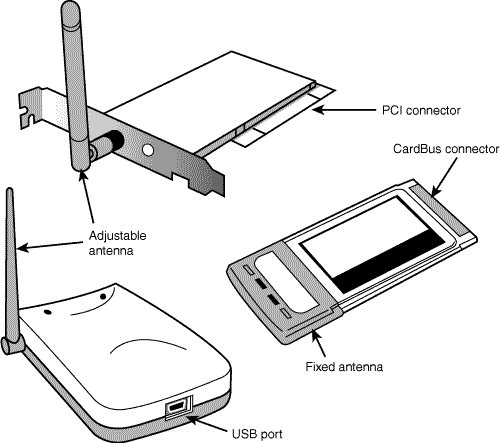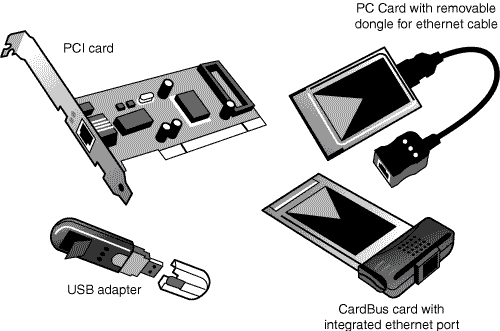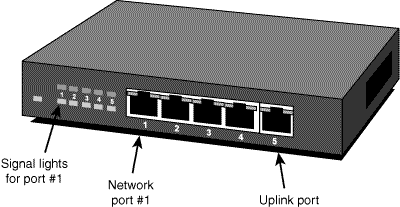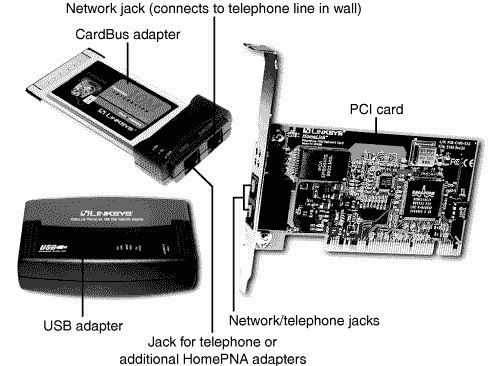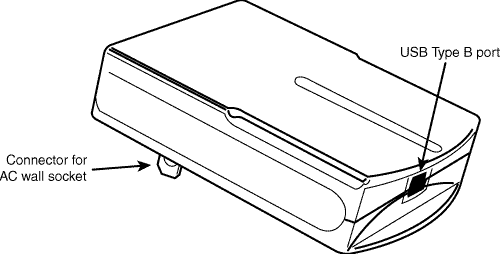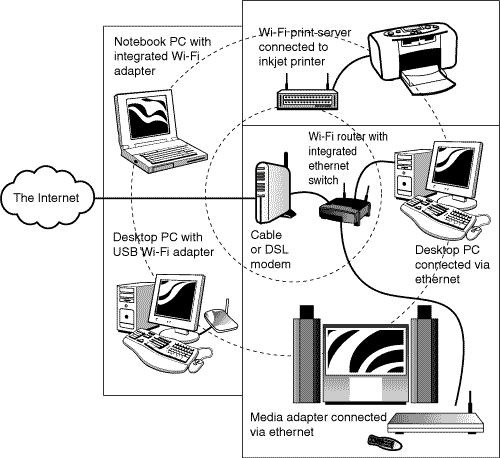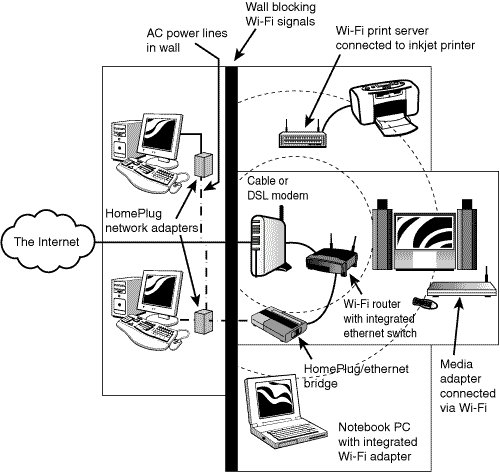IN THIS CHAPTER
A home network can connect your computers and home entertainment devices to make them more fun and more powerful. In this chapter, you discover the hardware options you can choose from to make your home network dreams come true.
In Chapter 1, “What Is a Home Network?” you learned about the many benefits of home networking:
Interactive gaming
Enjoying digital media
Securely working from home
Learning and education
You explored combinations of computers and other devices that can be connected via a home network. In this chapter, you learn what connects the parts of a home network.
As you learned in Chapter 1, a network is any collection of computers and devices that share information with each other. There are many different types of networks on the market. The following sections discuss the major features of each type of network.
Traditionally, the least expensive network to buy has been a wired network. A wired network connects its components with some type of signal cable. If you plan to work at home, some types of wired networks also provide the fastest connections possible between computers and devices.
There are three major types of wired networks:
ethernet
HomePNA (phoneline)
HomePlug (powerline)
Note: Gigabit Ethernet Plays Nice with Slower Speeds

A few new computers include Gigabit Ethernet, which runs at 1,000Mbps, but also works with 10BASE-T and 10/100 Ethernet adapters.
Ethernet is the oldest network technology suitable for home use; although its earliest form was developed more than 30 years ago for business, Ethernet continues to be the most common wired network in both home and business environments, and it also can be used alongside wireless networks.
Many recent desktop and notebook computers incorporate a 10/100 Ethernet adapter. Depending on the devices it is connected to, this type of Ethernet adapter runs at either 10Mbps (also known as 10BASE-T) or 100Mbps (Fast Ethernet) speeds. If your computer doesn’t include an Ethernet adapter, you can add one for less than $50 in most cases.
Ethernet network adapters communicate with each other through a centralized device known as a hub or a switch. Most network hardware—including broadband Internet access devices, home media players, and network-compatible video games—supports Ethernet.
HomePNA network adapters connect to your home telephone wiring, so you don’t need to run additional cables through your home. That feature makes HomePNA attractive, as does HomePNA’s capability of working without interfering with normal telephone use (you can plug your phone into the adapter; a separate cable runs from the adapter to the telephone jack in the wall).
Note: Understanding HomePNA, DSL, and Dial-Up Modems

HomePNA, DSL Internet access, and dial-up modem Internet access all use telephone lines, but they’re otherwise very different. HomePNA connects computers within your home to each other via the telephone lines in the walls of your home, and it can be used to share various types of Internet access. DSL Internet access piggybacks on the telephone line coming into your home, enabling you to connect to the Internet and talk on the telephone at the same time. Dial-up modems also connect to the Internet, but prevent you from using your telephone while the connection is active.
However, there are two major drawbacks to using HomePNA as your only network:
You need to add HomePNA adapters to your PC; hardly any PCs include a HomePNA adapter.
Although you can get HomePNA-compatible routers for shared Internet access, there are very few home entertainment devices that are HomePNA-compatible.
Consequently, I suggest you look at HomePNA primarily as a means of extending the reach of an Ethernet or wireless Ethernet network. Most HomePNA products on the market today support HomePNA 2.0, which runs at 10Mbps; avoid HomePNA 1.0 network adapters, which run at just 1Mbps. Although HomePNA 2.0 runs at only a tenth of the speed of Fast Ethernet, it is fast enough for accessing shared folders and shared printers and for Internet access.
HomePlug uses the power lines in your home to connect your computers. A HomePlug adapter plugs into an electrical outlet and uses a USB cable to connect to your computer.
Note: “Bridging” the Differences Between HomePNA and Ethernet

You can interconnect HomePNA and Ethernet networks together with a device known as a bridge. A bridge also enables you to add Ethernet-compatible devices to a HomePNA network.
HomePlug networks run at a top speed of 14Mbps, slower than Fast Ethernet, but fast enough for accessing shared folders and shared printers and for Internet access.
Like HomePNA, HomePlug can be connected to Ethernet networks through a bridge, so it can be used where Ethernet wiring is not feasible.
Networking without wires has become a reality in both home and office environments. Wireless networking isn’t much more expensive these days than wired Ethernet, and is the hottest home networking trend today.
Note: Powerline Networking for Internet Access

In the future, you might also get broadband Internet access through the powerline connection coming into your home. Broadband over Powerline (BPL) is already being tested in some U.S. markets. See Chapter 4, “Choosing a Broadband Internet Access Technology,” for more information.
Although several types of infrared and radio-frequency networks have come and gone over the years, there are only two major flavors of wireless networking on the market today:
Wireless Ethernet (often called Wi-Fi)
Bluetooth
Wireless Ethernet (officially known as the IEEE-802.11 family of standards) is the hottest network technology right now, and no wonder. Radio waves carry network traffic hundreds of feet indoors and out, so you don’t have the mess or expense of network cable. The same hardware works in home and office wireless networks, so you can use your notebook computer, PDA, or smart phone with wireless Ethernet in both places to connect to the Internet. Wireless Ethernet home networking works with game consoles and home entertainment hardware, too, so you can create a 100% wireless home network that covers all your information, entertainment, and education needs.
Caution: Say Goodbye to HomeRF

The HomeRF network was a popular choice for wireless networking before the rise of Wireless Ethernet, but the HomeRF standard and products have been discontinued. HomeRF networks were sold by Proxim and other vendors. If you have a HomeRF network, it’s time to consider other options such as Wireless Ethernet (Wi-Fi).
Because wireless Ethernet is based on Ethernet, it’s easy to connect these networks to each other. In fact, most wireless access points (which transmit signals between wireless Ethernet stations) include an Ethernet network switch. My home network includes both wired and wireless connections.
There are a couple of complicating factors to keep in mind when you consider wireless Ethernet:
Frequencies
Wi-Fi Certified and noncertified hardware
Tip: Taking Wireless Ethernet Everywhere

When you travel, you can find wireless Ethernet access (often referred to as hot spots) available in an increasing number of public places, such as libraries, airports, hotels, and restaurants. So, take your notebook or PDA with you and keep an eye on your home network.
Wireless Ethernet and Wi-Fi are often considered the same thing. That’s not exactly correct. Wi-Fi hardware is wireless Ethernet hardware that has passed the Wi-Fi Alliance (http://www.wi-fi.org) certification tests for interoperability with other brands of hardware. In other words, all Wi-Fi Certified hardware is wireless Ethernet, but not all wireless Ethernet hardware is Wi-Fi Certified. If you want to mix-and-match wireless Ethernet hardware in your home network, or to help assure that you can use the same wireless Ethernet adapter at home and at the office or while traveling, be sure to look for Wi-Fi Certified hardware. Wi-Fi Certified hardware is marked with one of the labels shown in Figure 2.1. The simpler labels in the middle and right of Figure 2.1 have recently been introduced to help users more easily determine which 802.11 standard is supported by a particular Wi-Fi product. The check marks on the label at left indicate which Wi-Fi certifications and frequencies the device supports. The product in the figure supports IEEE 802.11b (11Mbps) speeds and WPA security, but can also connect with IEEE 802.11g (54Mbps) devices because both use the 2.4GHz frequency.
Although there are three different flavors of Wi-Fi, the best one to build your home network around is IEEE 802.11g (Wireless-G). There are several reasons to make this your choice:
Wireless-G equipment uses the same radio frequency, 2.4GHz, as Wireless-B (B is the original version of Wi-Fi), so G and B equipment works on the same network.
Wireless-G is up to five times faster than Wireless-B (when you use Wireless-G network adapters and wireless access points), so your wireless network is faster.
Wireless-G hardware is easy to find at any store that stocks Wi-Fi and wireless Ethernet hardware.
What about Wireless-B? You should consider Wireless-B hardware when Wireless-G hardware is not available for a particular task. For example, although Wireless-G network adapters and wireless access points are widely available, media adapters and other specialized equipment are often available only in Wireless-B speeds. Also, many notebooks with integrated Wi-Fi adapters, such as those equipped with the original version of Intel’s Centrino technology, support Wireless-B.
What about Wireless-A? Wireless-A was originally developed to provide better performance and longer range in a corporate environment than Wireless-B. Wireless-A uses a different radio frequency (5GHz) than a Wireless-G or Wireless-B network (2.4GHz), so it can’t connect to these networks unless dual-band (A+B or A+G) hardware is used. Dual-mode A+G network adapters enable a computer to connect to home and corporate wireless networks and public hotspots with a single adapter. Linksys has developed dual-band A+G hardware for home networks that routes streaming video and other high-bandwidth traffic over the 5GHz frequency while web surfing and other traffic is routed over the 2.4GHz frequency.
Wi-Fi and wireless Ethernet networks can be configured in a peer-to-peer mode for direct connection between computers or devices. However, this mode won’t work for Internet sharing or for connections to other networks. Instead, use the infrastructure mode, which uses a wireless access point to transfer signals between computers.
Tip: B & G—Happy Together, but at a Price

Many Wireless-G wireless access points and routers provide slower performance in networks that have both Wireless-B and Wireless-G hardware. If you’re looking for maximum performance in a mixed B/G network, be sure to look at product reviews at sources such as PC World (http://www.pcworld.com), PC Magazine (http://www.pcmag.com), PracticallyNetworked (http://www.practicallynetworked.com), and others to see which devices provide the best performance in a mixed network.
Many PC peripherals—such as printers, mice, and keyboards—and non-PC electronics products—from digicams to cell phones—have built-in Bluetooth capability. Bluetooth capability can be added to other devices.
However, Bluetooth is not a full-blown home network. Bluetooth is used between pairs of devices for data exchange, rather than as a full-blown network with the capability of sharing Internet access, printers, folders, or media files. Its speed is only 500Kbps.
As I suggested in Chapter 1, broadband Internet access has become the number one reason for setting up a home network. Instead of fighting over seat time at the PC with the fast Internet connection, you can install a home network and give everybody equal access to home banking, homework sites, digital music servers, movie trailers, weather, online gaming, and much more.
Broadband Internet access is often defined as Internet access with download speeds more than 100Kbps; in practice, most providers support download speeds of 384Kbps or faster (more than seven times faster than the fastest dial-up modem). And, although some older types of broadband Internet access used an ordinary dial-up modem for uploads (tying up your phone line), almost all broadband Internet service today is two-way service, which doesn’t interfere with your ability to take or make telephone calls.
A home network designed for sharing broadband Internet access resembles a home network that shares peripherals, but with a couple of differences:
The leading broadband Internet service types include cable (brought to you by your friendly cable TV company) and DSL (brought to you in cooperation with your local phone company). However, they’re not the only choices. Whether you live in the city, the suburbs, or out in the country, you can get satellite Internet if you have an unobstructed view of the sky toward the equator. Other emerging broadband technologies include wireless and powerline.
Regardless of the type of broadband service you choose, almost all use some type of external device (often called an XXX modem—fill in the X’s with the service type) to make the connection. Figure 2.2 shows a typical cable modem, which connects your computer to the cable TV network.
Sharing an Internet connection may be the number one reason to build a home network. It’s been possible for several years, but as long as the Internet connection was being made with a slow dial-up modem that used the telephone line, it wasn’t all that useful to most users.
Dial-up Internet access prevents you from making telephone calls while you use the Internet, and you need special software or updated modems to be able to take telephone calls while you’re online. A dial-up connection is painfully slow for a single user, and even slower when two or more users are connecting at the same time.
However, when you combine broadband Internet access with a home network, everybody on the network and every device on the network can connect with the world’s largest network without tying up your telephone line.
There are a couple of ways to make the connection between your home network and the Internet:
You can connect your broadband Internet device to your PC and add a second network adapter to connect the PC to the rest of the network.
You can connect your network to a router, which detects and routes traffic heading to or from the Internet to the correct computer on the home network.
The first method requires you to install Internet-sharing software on the PC connected to the Internet. Windows 98 Second Edition and later versions, including Windows XP, offer Internet Connection Sharing (ICS). One major drawback of ICS is that when the ICS host PC is turned off or locks up, Internet access fails for everybody on the network.
The second method helps protect all your PCs against intruders and doesn’t care which PCs are running at any time. Most routers made for wired Ethernet networks include a switch, so you can replace your switch with a router and use one device for both jobs. Similarly, wireless routers also act as access points, so one device connects the wireless stations to each other and to the Internet. Most wireless routers, such as the one shown in Figure 2.3, also include a switch, so you can network wired and wireless computers together.
Tip: Router or Switch? Here’s How to Tell the Difference

Routers have a WAN (wide area network) port (Figure 2.3). The WAN port connects the router to the broadband Internet device. It’s often located next to the switch ports for each computer (they’re usually numbered starting with 1). If you don’t see a WAN port, you don’t have a router.
Routers are available for all the home networks covered in this book, including Ethernet, Wi-Fi, HomePNA, and HomePlug.
As the previous sections suggest, you can mix and match network hardware through the use of bridges, switches, or dual-frequency network adapters. Although it’s sometimes easier to run a “pure” network, one that uses only a single network standard, mix-and-match networking can help you
Bridge coverage gaps in a wireless network.
Extend an existing network without rewiring.
I show you specific examples of mix-and-match networking to solve these and similar problems later in this chapter.
A home network, like any network, has three types of components:
Network hardware
Network software
Network protocols
If any one of these is missing, has failed, or is not configured properly, your home network turns into a disjointed collection of standalone components.
To create a home network, you need to connect the computers and other devices on the network to each other. This requires at least three elements:
Network adapters (devices to connect each computer to the network)
A method of transmitting data between computers (cable or radio waves)
A method of coordinating the exchange of data (a hub, switch, or wireless access point)
Most home networks are used to share Internet access, so two additional components are needed to connect the network to the Internet: a router or gateway, and a broadband Internet access device such as a cable, DSL, satellite, or fixed wireless broadband modem.
Although computers sometimes include a network adapter, you must buy other components to complete your home network, particularly if you want to share Internet access. Network software is provided by the maker of your network hardware if the necessary software is not already part of your version of Windows or other operating system. Network protocols are provided as part of Windows or other operating systems.
It can be confusing to figure out exactly what you need to build the network you have in mind. In the following sections, I’ll show you each type of network hardware and provide you with a shopping list for each type of network.
Note: Save Money with Combination Devices

Although switches, wireless access points, and routers can be separate devices, you can usually buy combination devices that include multiple functions. For example, most wireless access points made for home networks also include a router, and most also include an Ethernet switch. I recommend using combo devices because they save money and space. A single device is also easier to cable and easier to hide!
A Wi-Fi network needs the following components:
Wi-Fi adapter for each PC or other device on the network
A Wi-Fi network that will be used to provide Internet access also needs:
Wireless access point (WAP)
Router (to connect the network to broadband Internet service)
Typically, the WAP and router are combined into a single unit, which might also contain a built-in Ethernet switch.
How do these components fit together? Read on!
A network adapter is an internal card or external device that enables a computer or other device to connect to a network and exchange data with other computers. A Wi-Fi network adapter must use a standard (Wireless-G, B, or A) that is the same, or is compatible with, other computers and devices on the network.
Figure 2.4 provides examples of different types of network adapters used by Wi-Fi wireless networks.
If you’re adding a portable computer (laptop or PDA) to your home network, it might already include a built-in Wi-Fi adapter. Check your system documentation to find out whether it does. If your computer doesn’t have a Wi-Fi adapter, you need to add one. Table 2.1 reviews your choices.
Table 2.1. Wi-Fi Network Adapter Types
Network Adapter | Connection Type | Computer Type | Notes | Benefits |
|---|---|---|---|---|
External USB | USB port | Desktop or notebook PC | USB 2.0 devices; can also work with slower USB 1.1 ports | Easy to move between computers; some also work with console game systems |
Internal PCI card | PCI slot | Desktop PC | Requires opening the case | Faster than USB 1.1 adapters |
Internal Type II CardBus | CardBus slot | Notebook PC | 32-bit (wide, fast connection) version of PC Card | Faster than USB 1.1 adapters |
Although you can build a so-called ad hoc network by using Wi-Fi adapters, a Wi-Fi network running in ad hoc mode doesn’t support shared Internet access. To share Internet access, you need a wireless access point and a router, and you need to configure your Wi-Fi hardware to run in infrastructure mode.
If you want to build a home Wi-Fi network with a potentially global reach, you need to include a wireless access point (WAP) and a router in your network.
A WAP transmits radio signals between stations on a Wi-Fi network and can relay signals between the network and a router. A router connects one network to another. A WAP and a router can be combined into a single unit. When you have broadband Internet, you have a connection to the world’s biggest network (the Internet), and a router connects your home network with the Internet. Figure 2.5 shows a typical access point with integrated router and switch.
If parts of your home or property are too far away from a WAP to enjoy a fast or reliable connection, you can add additional WAPs that can relay the signal to the WAP/router or replace the standard antennas on the WAP/router with more powerful versions to improve network performance and reliability.
Home networking isn’t just for PCs anymore, and Wi-Fi networking can be used to connect a wide variety of devices to your home network:
Printers—. Move your printer away from your PC to a more central location by connecting it to a Wi-Fi print server.
Home theater and big-screen TV—. View video or photos or play back digital music in your living room or den by adding a Wi-Fi media adapter.
Console video games—. Play head-to-head or against online foes by adding a Wi-Fi game adapter to the network port on leading console games.
Home security—. Keep an eye on your home with a Wi-Fi video camera or Wi-Fi enabled home security system.
Figure 2.6 illustrates some of these specialized devices.
When you take both Wireless-G and Wireless-B devices into account, a Wi-Fi home network can include almost any computing or entertainment device you can imagine. As a consequence, there are many configurations possible. The following sections outline two typical configurations to consider.
In this configuration, you use Wi-Fi strictly for local networking between PCs and add a media adapter so you can play media through your home theater system. Figure 2.7 shows you how this network might look.
Optional components are available. In configuration 1, you can add any other Wi-Fi adapters that can run in ad hoc (peer-to-peer) mode, such as print servers, but you cannot share an Internet connection.
This configuration is great for working and learning at home. By sharing broadband Internet access with the network, everyone can use the Internet for learning, research, and fun. A print server enables you to put the printer where it’s convenient for all users. Figure 2.8 shows you how this configuration might look.
Optional components also are available with configuration 2. You can add any other Wi-Fi adapters that can run in infrastructure mode, such as media adapters, game adapters, wireless video cameras, and practically all other Wi-Fi devices.
An Ethernet network needs the following components:
Ethernet adapter for each PC or other device on the network
A switch or hub to transfer data between each computer or other device on the network
A CAT5-or-better network cable between each PC and each port on the hub or switch
An Ethernet network that will be used to provide Internet access also needs the following:
A router (to connect the network to broadband Internet service)
Typically, the router includes a built-in Ethernet switch.
How do these components fit together? Read on!
Although many recent systems have a built-in 10/100 Ethernet adapter (such an adapter runs at 10Mbps or 100Mbps, depending on the switch or hub it is connected to), you might need to add an Ethernet adapter to a PC you want to add to a network.
Most Ethernet network adapters sold today support 10/100 Ethernet; although some vendors now sell Gigabit Ethernet (10/100/1000) adapters, there’s no reason to get one unless you’re willing to equip your entire network with gigabit adapters and switches.
Figure 2.9 provides examples of different types of network adapters used by Ethernet networks. The PCI card adapter (top left) plugs into an empty PCI card slot in a desktop computer. The USB adapter (bottom left) plugs into the USB port on any recent computer. The PC Card adapter (top right) fits into any notebook computer’s Type II PC Card slot. However, most recent notebook computers can use the faster CardBus card (bottom right).
Wired Ethernet networks use Category (CAT) 5, 5e, or 6 cable. This type of cable runs between each PC’s network adapter and the hub or switch that relays information between PCs.
Both wired and wireless routers, which connect home networks to the Internet, connect to cable modems and other broadband access devices with a CAT 5/5e/6 cable.
Note: “Wireless” Ethernet Sometimes Needs a Cable

It’s often easier to configure a Wi-Fi WAP, game adapter, or other device by connecting it to a wired Ethernet port on a PC. That’s one reason why many Wi-Fi devices also have a 10BASE-T or 10/100 Ethernet port.
The connector on the end of a CAT5/5e/6 cable is known as an RJ-45 connector. It has eight connectors and resembles the RJ-11 connector used by telephones, dial-up modems, HomePNA networks, and DSL internet access. Figure 2.10 compares RJ-45 and RJ-11 connectors to the USB connectors used on some types of network adapters.
The center of attention in a wired Ethernet network is a hub or switch. A CAT5/5e/6 cable (refer to Figure 2.10) connects each computer on the network to a hub or switch, which transmits data between computers on the network.
Tip

If your home network will also be used for sharing an Internet connection, you can buy a wide variety of routers that incorporate switches.
Although hubs and switches look similar (both have multiple RJ-45 ports on one side of the unit and signal lights on the front or top), they work in different ways. A hub broadcasts all the data it receives to all the computers plugged into it; a switch sets up a direct connection between transmitter and receiver, making for a faster connection. Switches also support the full speed of the network adapters in use; hubs subdivide the available speed of the network among the computers plugged into the hub. At one time, switches were much more expensive than hubs, but today hubs have been largely replaced by low-cost switches. Figure 2.11 shows a typical switch.
If you want to share Internet access through an Ethernet network, you should use a router with an integrated switch instead of a switch. The WAN port on the router connects to the broadband Internet access device, and the LAN ports on the router connect to the PCs on the home network.
Like its wireless sibling, Wi-Fi, Ethernet also offers a host of specialized devices that can spread home networking goodness beyond your PCs. In fact, some print servers, media adapters, and game adapters that are primarily marketed to Wi-Fi users also work with Ethernet networks.
Note: Network Cable Categories

Although CAT5, CAT5e, and CAT6 can all be used with 10/100 Ethernet and Gigabit Ethernet networks and use the same connectors, there are some differences between them. CAT5e supports the same wire speeds as CAT5, but meets certification standards that are not specified for CAT5. CAT6 supports faster wire speeds than CAT5 or 5e, but for home networks all three are essentially interchangeable. Get the technical lowdown on the entire range of network cable standards from the Discount Cables USA Ethernet Cables page at http://discountcablesusa.com/ethernet-cables.html.
An Ethernet home network can support a wide variety of PCs and other devices. Here are two typical configurations to consider.
In this configuration, you use a crossover RJ-45 cable to make a direct connection between two PCs’ Ethernet ports. You can’t share Internet access or add additional PCs with this configuration, but for simple folder and printer sharing between two computers, it works very nicely.
Note: Crossover and Standard CAT5/5e/6 Cables

A normal CAT5/5e/6 cable has matching wire pairs at each end. A crossover cable reverses some of the wire pairs. If you build a two-station network similar to the one shown in Figure 2.12 and later decide to expand it with a router or switch, you need to replace the crossover cable with standard cables that run from each PC to the switch. Be sure to mark the crossover cable so you don’t mix it up with standard cables.
This configuration has no optional components. You can share additional printers, drives, or similar devices connected to either PC in a two-station network, but you cannot add other computers or network devices. If either computer has an Internet connection (dial-up or broadband), it cannot be shared using this configuration.
In this configuration, you have a great setup for working and learning at home. By sharing broadband Internet access with the network, everyone can use the Internet for learning, research, and fun. A print server enables you to put the printer where it’s convenient for all users, and a media adapter allows you to play audio and other types of media through your home theater system. Figure 2.13 shows you how this configuration might look.
Optional components are available in configuration 2. You can add as many computers or other devices as you want—including game systems, projectors, and others—by connecting them to the appropriate Ethernet adapter. If you need additional ports for new devices, you can add a switch to the uplink port on the router’s integrated switch.
A HomePNA network needs the following components:
One HomePNA adapter for each PC or other device on the network
A HomePNA network that will be used to provide Internet access also needs the following:
A router (to connect the network to broadband Internet service)
Keep reading to see how the pieces of a HomePNA network fit together.
It’s extremely rare for a computer to include a HomePNA network adapter. Consequently, you need to add a HomePNA network adapter to virtually any PC that you’d like to add to a HomePNA network. HomePNA network adapters can be installed in a desktop computer’s PCI slot or a notebook computer’s PC Card or CardBus slot, or can plug into a USB port. Figure 2.14 illustrates typical HomePNA network adapters.
Unlike Ethernet, which requires a hub or switch if more than two computers are used, a HomePNA network uses daisy-chaining to connect to the rest of the network. A HomePNA 2.0 network can handle up to 50 HomePNA network adapters using up to 1,000 feet of telephone cable—far more than enough for the typical home network.
If all you want is to share files and printers, you’re set.
As with other types of home networks, a router is necessary if you want to use your HomePNA network to share an Internet connection. A HomePNA router resembles an Ethernet router, but it includes one or more HomePNA ports.
Some routers made for HomePNA networks can also connect to Ethernet networks. These routers have a single LAN port, which must be connected to an external switch.
Unlike Ethernet and Wi-Fi, HomePNA product offerings are generally limited to adapters for PCs and routers. There are few digital entertainment products available for HomePNA.
However, you can bridge an Ethernet network to your HomePNA network. This enables you to use Ethernet-based home entertainment, gaming, and multimedia adapters with your HomePNA network.
There are two basic configurations possible in a pure HomePNA network.
In this configuration, your HomePNA network is used for file and printer sharing. Figure 2.15 shows you how this configuration might look.
Optional components include other HomePNA adapters, including media adapters.
In this configuration, everyone can use the Internet for learning, research, and fun. Figure 2.16 shows you how this configuration might look.
Optional components include other HomePNA adapters, including media adapters.
A HomePlug home network needs the following components:
One HomePlug adapter for each PC you want to add to the network
If you want to share an Internet connection, you also need the following:
A router
To learn more about HomePlug hardware, read on.
Tip: Mixing HomePNA with Other Networks

For more information about using HomePNA with other networks, see “Building a Mix-and-Match Network,” p. xxx, later in this chapter.
HomePlug adapters plug into the AC wall socket. They connect to both desktop and notebook computers through USB ports. Figure 2.17 shows a typical HomePlug adapter.
HomePlug, like HomePNA, uses a peer-to-peer connection between computers. Thus, if you don’t need shared Internet access, a HomePlug adapter for each PC is all you need to create a home network.
If you want to share Internet access on a HomePlug network, you need a router that is compatible with HomePlug, or one that can connect to a HomePlug network. Although several vendors make HomePlug-to-Ethernet bridges that can be used to connect HomePlug networks to an Ethernet-based router, routers with built-in HomePlug support are also available. A HomePlug router resembles an Ethernet router, but it includes a HomePlug connection to an AC power line.
Some of these routers also include an Ethernet switch, enabling you to connect Ethernet and HomePlug networks to the same broadband Internet connection.
HomePlug is the newest home network technology on the market, and so far it is being used only for PC-to-PC connectivity. However, you can bridge an Ethernet network to your HomePlug network. This enables you to use Ethernet-based home entertainment and multimedia adapters with your HomePlug network.
Tip: Mixing HomePlug with Other Networks

For more information about using HomePlug with other networks, see the next section, “Building a Mix-and-Match Network.”
A HomePlug network uses a peer-to-peer connection similar to a HomePNA network, except that HomePNA uses the telephone lines in your walls and HomePlug uses the AC power lines. Refer to Figures 2.15 and 2.16 for examples of typical configurations.
Although this chapter examines several different network technologies, it’s increasingly common to build a home network that mixes and matches network technologies. What are the benefits of mix-and-match networking?
Cost savings—. By using wired network connections for systems or devices that are near your router and using wireless connections for more distant devices, you save money. Wired network adapters, particularly Ethernet, are less expensive than wireless adapters, but installing network cable, particularly if you hide the wire within the walls, can be costly.
Convenience—. If parts of your home are beyond the reach of your WAP, it can be easier to use HomePlug or HomePNA to bring the network within reach of certain rooms or locations than to try to use multiple WAPs or other methods to boost range.
Here are examples of two typical mix-and-match network configurations. Configurations similar to these might help you conquer a tough network job in your home
In this configuration (refer to Figure 2.18), the computer located next to the wireless router connects via its Ethernet port to the router’s built-in switch, and other computers use Wi-Fi access. The media adapter also connects via Ethernet, but the print server uses Wi-Fi. By putting the computer storing streaming media and the media adapter on Ethernet connections, the connection has more than enough speed to handle streaming video (which requires higher speeds than still photos or audio).
Ethernet or Wi-Fi devices of all types are available as optional components.
In this configuration (see Figure 2.19), a HomePlug network helps cover a part of the home where the Wi-Fi signal from the WAP/router is too weak for good coverage. This can happen because of building construction (brick or concrete walls can block Wi-Fi signals), antenna placement, or distance.
Wi-Fi or HomePlug adapters and devices are available optional components.
Windows, MacOS, and Linux operating systems are all network-ready as installed. You don’t need to install any third-party network software unless you want to improve security or add compatibility with a corporate network.
When you connect your computer to the home network, you might need to insert your operating system CD to install driver files or to enable file (folder) or printer sharing for a particular PC.
Tip: Use Your Home Network to Bring Old PCs up to Date

Starting with Windows 98, Microsoft has offered Windows and driver updates via Windows Update, a free online service. Windows Update is one of the best ways to add security updates and other improvements to Windows. However, many users don’t use Windows Update regularly because their computers connect to the Internet via a slow dial-up connection or don’t have any Internet connection. When you add your PCs to a home network with a broadband Internet connection, be sure to use Windows Update on each PC to download security and other patches and improvements. It will take some time the first time you do it, but your PCs will work better and be more secure.
You probably know that the Internet is the world’s largest network. What’s even more amazing is that there’s no requirement that you have a specific brand or type of computer or use a particular operating system to access the Internet. The latest Windows XP-based computer running a Pentium 4 or Athlon 64 process can exchange instant messages, email, or files with a low-end iMac running MacOS or an aging laptop running Windows 95. When your web browser requests a web page from a computer a continent away, the computer hosting the website could be running Linux, Unix, or some other operating system you’ve never heard of and might be big enough to fill a walk-in closet.
How is this seamless connection possible between radically different types of computers and hardware? Every device (computers, routers, home media players, and so on) that accesses the Internet must use a common “language” called Transport Control Protocol/Internet Protocol (TCP/IP). TCP/IP does the hard work of enabling Windows, MacOS, Linux, and other operating systems to talk to each other via the Internet.
Generally, when you add a network adapter to a PC, TCP/IP components are installed automatically as part of the process. Non-PC devices that work on home networks have TCP/IP support built in.
Home network hardware is designed to make TCP/IP configuration relatively simple when everything works as it ought to (the details are covered in the chapters on setting up each network). However, if you have problems, be sure to check out Chapter 11, “Troubleshooting Your Home Network,” for troubleshooting help and more background about TCP/IP.
Now that you understand the components used by each type of home network, it’s time to find out which network is best for you. See you in Chapter 3.




